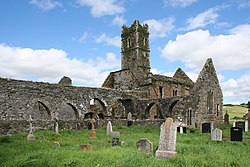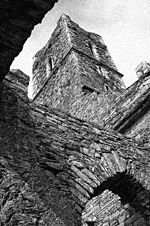Timoleague
| Timoleague Irish: Tigh Molaige | |
| County Cork | |
|---|---|
 The ruins of Timoleague Abbey | |
| Location | |
| Grid reference: | W470437 |
| Location: | 51°38’37"N, 8°45’57"W |
| Data | |
| Population: | 381 (2016) |
| Postcode: | P72 |
| Local Government | |
| Council: | Clonakilty |
| Website: | www.timoleague.ie |
Timoleague is a village in County Cork, along the south coast between Kinsale and Clonakilty, on the estuary of the Argideen River. Nearby is the village of Courtmacsherry. It is about ten miles south of Bandon and thirty miles from Cork on the R600 coastal road.
History
Timoleague gets its name from its original Irish name Tigh Molaga, meaning the 'Home/House of Molaga'. St. Molaga was reputed to have brought beekeeping and honey production to Ireland. Honey production is still evident in the area. The village was formerly written as 'Tagumlag', 'Tymulagy', 'Tymoleague'.
Timoleague Friary was founded by the Franciscan order in 1240. The abbey was built on the site of a monastic settlement founded by Saint Molaga in the 6th century. The Four Masters state that the Monastery of Timoleague was founded by MacCarthy Reagh, who lived near Kinsale, in 1240. The McCarthys were over-lords of Corca Laidhe, at least since the 13th century, and received tribute from the chiefs of the district. The abbey was extended by Donal Glas McCarthy in 1312, and by Irish and Norman patrons in the 16th century. The monks were dispersed by the Reformation, but returned in 1604. In 1612, the abbey was sacked by English soldiers who also smashed all of the stained glass windows, but much of the significant architecture remains. The friars remained in the abbey until 1642 when the friary and town were burnt by soldiers under Lord Forbes.
The Cistercian Order founded Abbeymahon Abbey in 1172 under Dermot MacCormac MacCarthy, King of Desmond. The site was originally at Aghamanister and was colonized with a group of monks from Baltinglass. Almost a century lapsed before the monks decided to move to a new site. The monks moved to Abbeymahon in 1278 when Diarmuit MacCarthaig, son of Domnall Cairbreach, was buried in the new monastery.
The town of Timoleague and much of the adjacent country belonged to the Hodnetts, a family who settled in the area from Shropshire. Before this, it belonged to the O'Cowigs. In the reign of Henry III, a great battle was fought at Timoleague, between the Hodnetts, under Lord Phillip Hodnett, and the Barrys, under Lord Barrymore. The Hodnetts were routed, and their leader was killed. The Barrymores then became the owners of Timoleague, and they and their descendants retained possession until the 1800s, when the estate was purchased by the Travers family.
In 1832, the Timoleague parish priest, Reverend Mr Charles Ferguson, was murdered when trying to collect tithes by force.
Places of interest
- The remains of Timoleague Friary, founded in 1240 on the site of Saint Molaga's manastic settlement of the 6th century.
- The ruins of Abbeymahon Abbey. The abbey was founded in 1172 by Dermot MacCormac MacCarthy, King of Desmond. The site was originally at Aghamanister and was colonized with a group of monks from Baltinglass. Almost a century lapsed before the monks decided to move to a new site. The monks moved to Abbeymahon in 1278 when Diarmuit MacCarthaig, son of Domnall Cairbreach, was buried in the new monastery.
The Church of Ireland church, the Church of the Ascension, is also decorated internally in mosaic work carried out and paid for by the Travers family and the final wall completed by the then Maharajah of Gwalior (Madho Rao Scindia) of India in 1925 in memory of his doctor, Dr Crofts, who came from Timoleague. The church itself dates from 1811.[1]
Society
Timoleague Brown Pudding, a type of blood sausage, has been granted Protected Geographical Status under law.[2]
Timoleague has the highest proportion of Polish people of any settlement in Ireland at 25% of the population of the village, according to the 2011 census.[3]
The Timoleague Harvest Festival is held every year in August.[4]
Sport
- Gaelic sports: Argideen Rangers GAA
Outside links
| ("Wikimedia Commons" has material about Timoleague) |
References
- ↑ "Buildings of Ireland, Church of Ascension, Timoleague". http://www.buildingsofireland.ie/niah/search.jsp?type=record&county=CO®no=20856005.
- ↑ "Official list of IE protected foods. Accessed 22 December July 2011.". http://ec.europa.eu/agriculture/quality/door/registeredName.html?denominationId=702.
- ↑ "Archived copy". http://www.eveningecho.ie/cork-news/census-figures-show-1560-polish-people-living-in-millstreet/21042/.
- ↑ "Timoleague Festival". http://www.timoleague.ie/festival. Retrieved 31 May 2021.
